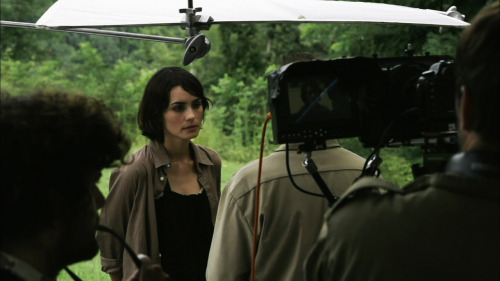 |
| (Road to Nowhere/Montery Media, Inc, 2010) |
As its title may suggest, Road to Nowhere is a bit of stilted, if admirable, poetry. Its opening scene says nothing more than "Get this"; a girl sits down in a drab neon room and injects a disk with the title “Road to Nowhere” scrawled on it into her laptop. We zoom in on the screen, showing a girl lying on a bed at night, drying her hair with a blow dryer. For the next few minutes, which include credits and a song, we are in the film “Road to Nowhere” directed by Mitchell Haven. Then we get back outside that movie. Haven (Tygh Runyan) is being interviewed from prison by a reporter who wants to know all about how and why he came around to making a film based on a real-life murder in North Carolina. In flashbacks, with inserted scenes from his film, Haven casts a mysterious, pretty girl named Laurel (Shannyn Sossamon) who insists that she’s not really an actress, though she looks exactly like the woman Velma, the real-life culprit in the murder. But it appears, based on Laurel's secret conversations with another actor that she may in fact have something to hide.
Bodies disappear. State funds disappear. Haven becomes infatuated with Laurel, even as his creative consultant (Waylon Payne) and a pesky blogger (Dominique Swain) are on his and Laurel’s tails. Yet what never even makes an appearance is internal logic. Haven and his actress fall in love. Fine, but why, aside from her being physically gorgeous? Why does their relationship remain in blissful stasis until the very end? The recognition, by those working with Haven on his film, that this is a dangerous relationship is the most interesting point of conflict in the film, but it brings up even more illogicalities. Why stage a crucial scene near the dark entrance to a tunnel, and then back away from the scene before it can be played out? And if about half of what we’re seeing is, in fact, staged footage, how did it even get to the point of being assembled, given what transpires?
 |
| (Road to Nowhere/Montery Media, Inc 2010) |
It is these questions that stay on our minds more than director Monte Hellman’s wishful pandering to the what-is real-and-what-is-not-ideal that has blown up so much of recent cinema. The 78-year old Hellman has completed his first feature with this film since 1989, and he seems desperately eager to catch up on things. Twitter, Facebook, DSLR cameras and talk shows figure prominently in this film, and it looks like Hellman has been watching Michael Haneke and Christopher Nolan’s films to get a sense of what’s arty these days. But Road to Nowhere, despite beautiful photography by Joseph M Civit, never manages to transcend anything beyond the above summary. We can be grateful that the wonderful actress Shannyn Sossamon carries so many of the scenes with pure charm, and that we are as in love with her as Mitchell Haven is. For example, one small early scene that shows her putting on her socks is a lovely, seductive bit of acting. But we’re also as in love with her as Hellman, and in the way he frequently shoots her half-clothed or implicitly naked, we feel like we are indulging in someone else’s fantasy (a concept mentioned several times in the film). The film never escapes the impression of being by and for out of touch, dirty old men.
But Hellman’s main subject is that which is as obvious as air: filmmaking. He rightly wants to get us thinking about what a filmmaker does to their collaborators through their visions, and what harm they cause themselves through obsession. But look: a good book about writing should make writing look vigorous, alive, and sensible. Hellman’s film about filmmaking makes the whole craft look obnoxious. He wants us to take a man who insists that it matters when a bottle is full of tequila instead of rum as a sympathetic director-figure. He wants us to believe that merely looking at scenes from films like The Seventh Seal on a T.V screen will remind us of what good filmmakers aspire towards. He thinks that a director’s “vision” is something so sacrosanct that it is perfectly natural to accept no compromises and to act like a general pain in the ass. All of which can be seen in the figure of Mitchell Haven. Some people might go in to Road to Nowhere thinking it will delve in to the strange logic of a filmmaker’s personal life and their films, like what Fellini did in 8 ½ . Instead, they’ll get an old director showing them that a filmmaker should be bearded and stubborn; well, plenty of them are.